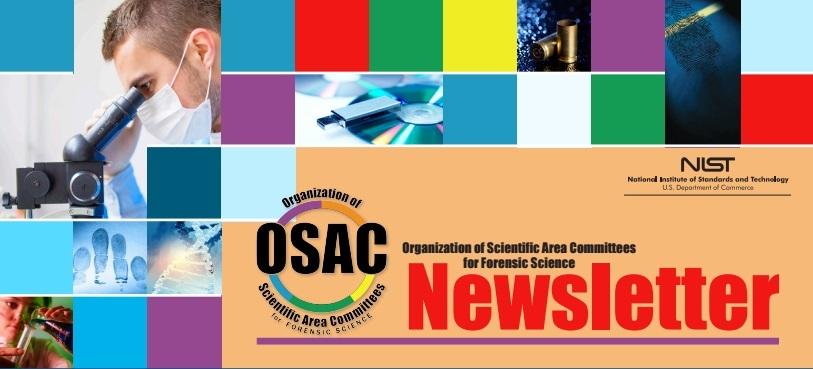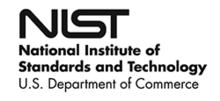OSAC Newsletter, December 2016

December 2016
OSAC Scientific Area Committees Public Status Reports & Open Discussions | Message from the FSSB: Discipline-Specific Baseline Documents Posted to OSAC Subcommittee Websites | Standards Developing Organization (SDO) News | Status of Standards Documents Recommended for Inclusion on the OSAC Registries | Research & Development Needs | On the Horizon | NIST Activities
OSAC Scientific Area Committees Public Status Reports & Open Discussions
Please join us for the upcoming Organization of Scientific Area Committee for Forensic Science (OSAC) Public Status Reports & Open Discussion meetings taking place in New Orleans, LA, February 13-14, 2017, as part of the American Academy of Forensic Sciences (AAFS) annual meeting.
Attendees of the OSAC sessions at the AAFS meeting will be the first to hear about OSAC’s recent standards and guidelines activities and priorities. The OSAC is a collaborative body composed of more than 550 forensic science practitioners and other experts drawn from local, state, and federal agencies, academia, and industry. The OSAC mission is to strengthen the nation's use of forensic science by supporting the development and promulgation of technically sound forensic science consensus documentary standards and guidelines. Thirty separate presentations will be provided by committee chairs (or their designees). Presentations and questions from the audience will be webcast live and archived for future on-demand viewing. The OSAC invites all to attend and participate.
Register now for the OSAC Scientific Area Committee Public Status Reports & Open Discussion.
Message from the FSSB: Discipline-Specific Baseline Documents Posted to OSAC Subcommittee Websites

The Forensic Science Standards Board (FSSB) serves as the Organization of Scientific Area Committees (OSAC) governing board.
The FSSB has recently provided the opportunity for OSAC Subcommittees to identify baseline documents and reference materials that best reflect the current state of the practice within their respective disciplines.
These documents contain practical information regarding these disciplines that can help forensic scientists, judges, lawyers, researchers, other interested parties and the general public, to better understand the nature, scope, and foundations of the individual disciplines as they are currently practiced.
It is important to note that the identification of these documents in this venue does not represent an endorsement by OSAC or NIST. All copyrights for these documents are reserved by their owners. Only documents that are posted on the OSAC Registries constitute OSAC endorsement.
As of December 2016, the subcommittees who have posted their discipline-specific baseline documents are the:
Standards Developing Organization (SDO) News
This section describes SDO activities relevant to the OSAC and forensic science community.
The American Academy of Forensic Science (AAFS) American Standards Board (ASB) Recent Activity
ASB has announced the preliminary development stage of new documents* in the December 2, 2016 issue of the ANSI Standards Action publication, see page 20 for information on the Project Initiation Notification System (PINS).
BSR/ASB Std 013-201x, Standard for Reporting Qualitative Source Conclusions (new standard) This document specifies the standard framework for reporting qualitative source conclusions, which may be augmented by quantitative data, resulting from the examination of friction ridge evidence. This document does not address conclusions derived directly from validated probability models or quantitative processes. Furthermore, this document does not address how examinations are conducted, documented, or criteria for sufficient justification of specific conclusions in a case at hand. Project Need: This document will provide needed guidance to practitioners in the field. Stakeholders: Friction ridge professionals.
BSR/ASB Std 014-201x, Standard for Training to Competency to Perform Friction Ridge Examination (new standard) This document specifies the minimum requirements for training to competency to perform friction ridge examination. It includes a list of modules and topics that shall be included in an organization's training program. This document is not a training program and does not address best practice recommendations for how training should be administered nor does it address minimum criteria for successful evaluation. Project Need: This document will provide needed guidance to practitioners in the field. Stakeholders: Friction ridge professionals.
BSR/ASB Std 015-201x, Standard for the Examination of Friction Ridge Evidence (new standard) This document includes the overarching examination framework as well as specific requirements for each component of the examination method. This document includes minimum requirements for how examinations shall be conducted, documented, and justified based on clearly demonstrable and articulable criteria. This document does not address specific requirements for quality assurance/quality control of the examination method. Project Need: This document specifies the minimum requirements for conducting friction ridge examinations. Stakeholders: Friction ridge professionals.
BSR/ASB Std 017-201x, Standard Practices for Measurement Traceability in Forensic Toxicology (new standard) This Standard will be developed to provide minimum requirements for establishing measurement traceability in Forensic Toxicology laboratories. Project Need: The fundamental reason for establishing traceability of a measurement is to ensure confidence and reliability in forensic toxicological test results. Stakeholders: Forensic toxicology professionals.
BSR/ASB Std 018-201x, Validation Standards for Probabilistic Genotyping Systems (new standard) Provides standards for the validation of probabilistic genotyping software. Project Need: This document is being generated to give guidance to laboratories validating probabilistic genotyping to ensure consistency within the discipline. This is especially important as it relates to inclusion statistics and mixture deconvolution. Stakeholders: Forensic biology professionals.
[*The submittal of a Project Initiation Notification System (PINS) is required by ANSI for the development, revision, reaffirmation or withdrawal candidate American National Standards (ANS). These notices are published in ANSI Standards Action. The notice is intended to serve as is an opportunity for deliberation among stakeholders and the opportunity to lodge a claim if there is a concern of conflict or duplication.]
Learn more about the AAFS American Standards Board (ASB) standards development process.
ASTM Committee E30 on Forensic Sciences Recent Activity
E30.1 Criminalistics
The following work items are underway:
WK56743 Training in the Forensic Examination of Human Hair
This practice is intended as a guide for use by laboratory personnel responsible for training forensic hair examiners to prepare them to perform microscopical hair examinations and microscopical human hair comparisons.
Learn more about the ASTM E30 standards development process.
Status of Standards Documents Recommended for Inclusion on the OSAC Registries
Want to know the status of standards documents that are under consideration for the OSAC Registries? Please visit the Status of Standards Documents OSAC webpage.
The aim of the Organization of Scientific Area Committees for Forensic Science (OSAC) is to identify and promote technically sound, consensus-based, fit-for-purpose documentary standards that are based on sound scientific principles. This will be achieved through the OSAC Registry of Approved Standards and the OSAC Registry of Approved Guidelines. A standard or guideline that is posted on either Registry demonstrates that the methods it contains have been assessed to be valid by forensic practitioners, academic researchers, measurement scientists, and statisticians through a consensus development process that allows participation and comment from all relevant stakeholders.
Below is a listing of standards or guidelines that are under consideration for the OSAC Registries, along with their status in the approval process.
Standards Documents Open for Public Comment
The intent of the public comment period is to collect public opinion on inclusion of the standard to the OSAC Registry (OSAC is not soliciting potential revisions to the documents themselves.)
There is nothing available for Public Comment at this time.
Standards Documents in Public Comment Adjudication Phase
Public comment period is closed for the following standards/guidelines as OSAC units review and adjudicate comments received.
ASTM E2388-11 Standard Guide for Minimum Training Requirements for Forensic Document Examiners (for consideration as an OSAC standard)
This guide many of the training requirements for Forensic Document Examiners, yet may not cover all aspects of training for the topics addressed or for unusual or uncommon examinations.
ASTM E2451-13 Standard Practice for Preserving Ignitable Liquids and Ignitable Liquid Residue Extracts from Fire Debris Samples (for consideration as an OSAC Guideline)
This practice describes procedures for preserving residues of ignitable liquids in extracts obtained from fire debris samples and questioned ignitable liquid samples.
Standards Documents at SAC for Vote
ISO/IEC 17020:2012 Requirements for the Operation of Various Types of Bodies Performing Inspection (for consideration as an OSAC Standard)
ISO/IEC 17020:2012 specifies requirements for the competence of bodies performing inspection and for the impartiality and consistency of their inspection activities.
It applies to inspection bodies of type A, B or C, as defined in ISO/IEC 17020:2012, and it applies to any stage of inspection.
Standards Documents at FSSB for Vote
ASTM E2330-12 Standard Test Method for Determination of Concentrations of Elements in Glass Samples Using Inductively Coupled Plasma Mass Spectrometry (ICP-MS) for Forensic Comparisons (for consideration as an OSAC Standard)
One objective of a forensic glass examination is to compare glass samples to determine if they can be discriminated using their physical, optical or chemical properties (for example, color, refractive index (RI), density, elemental composition). If the samples are distinguishable in any of these observed and measured properties, it may be concluded that they did not originate from the same source of broken glass. If the samples are indistinguishable in all of these observed and measured properties, the possibility that they originated from the same source of glass cannot be eliminated. The use of an elemental analysis method such as inductively coupled plasma mass spectrometry yields high discrimination among sources of glass. This test method covers a procedure for quantitative determination of the concentrations of magnesium (Mg), aluminum (Al), iron (Fe), titanium (Ti), manganese (Mn), rubidium (Rb), strontium (Sr), zirconium (Zr), barium (Ba), lanthanum (La), cerium (Ce), neodymium (Nd), samarium (Sm), and lead (Pb) in glass samples.
ASTM E2926-13 Standard Test Method for Forensic Comparison of Glass Using Micro X-ray Fluorescence (μ-XRF) Spectrometry (for consideration as an OSAC Standard)
This test method is for the determination of major, minor, and trace elements present in glass fragments. The elemental composition of a glass fragment can be measured through the use of μ-XRF analysis for comparisons of glass. This test method covers the application of μ-XRF using mono- and poly- capillary optics, and an energy dispersive X-ray detector (EDS).
Standards Documents in the Appeals Phase
The public appeals phase is open for the following standard. Appeals may only be submitted by individuals or groups that submitted a comment during the open public comment phase that believe their comment was not properly adjudicated. Submitted appeals must relate to the comment adjudication process, not technical issues.
ASTM E2548-11e1 Standard Guide for Sampling Seized Drugs for Qualitative and Quantitative Analysis (for consideration as an OSAC Standard)
This guide covers minimum considerations for sampling of seized drugs for qualitative and quantitative analysis.
Standards Documents Returned to SDO for Modifications Based on Comments
After careful consideration of the comments from the either the public and/or other OSAC committees, the OSAC has elected to submit the following documents to the SDO for revisions prior to proceeding through the OSAC process. They believe the issues raised during the comment period can be addressed by the SDO, and intend to bring the updated standards back through the OSAC Registry Approval Process.
ASTM E2881-13e1 Standard Test Method for Extraction and Derivatization of Vegetable Oils and Fats from Fire Debris and Liquid Samples with Analysis by Gas Chromatography-Mass Spectrometry (for consideration as an OSAC Standard)
This test method covers the extraction, derivatization, and identification of fatty acids indicative of vegetable oils and fats in fire debris and liquid samples. This procedure will also extract animal oils and fats, as these are similar in chemical composition to vegetable oils and fats. Herein, the phrase "oils and fats" will be used to refer to both animal and vegetable derived oils and fats. This test method is suitable for successfully extracting oil and fat residues having 8 to 24 carbon atoms.
ASTM E2916-13 Standard Terminology for Digital and Multimedia Evidence Examination (for consideration as an OSAC Guideline)
This document provides standard terminology for the subcommittees of Digital Evidence, Facial Identification, and Video Imaging Technology and Analysis.
ASTM E2825-12 Standard Guide for Forensic Digital Image Processing (for consideration as an OSAC Standard)
This document provides digital image processing standards to ensure the production of quality forensic imagery for use as evidence in a court of law. It briefly describes advantages, disadvantages, and potential limitations of each major digital imaging process.
ASTM E1610-14 Standard Guide for Forensic Paint Analysis and Comparison (for consideration as an OSAC Guideline)
This guide is designed to assist the forensic paint examiner in selecting and organizing an analytical scheme for identifying and comparing paints and coatings. The size and condition of the sample(s) will influence the selected analytical scheme.
ASTM E2937-13 Standard Guide for Using Infrared Spectroscopy in Forensic Paint Examinations (for consideration as an OSAC Guideline)
This guide applies to the forensic IR analysis of paints and coatings and is intended to supplement information presented in the Forensic Paint Analysis and Comparison Guidelines written by Scientific Working Group on Materials Analysis (SWGMAT). This guideline is limited to the discussion of Fourier Transform Infrared (FTIR) instruments and provides information on FTIR instrument setup, performance assessment, sample preparation, analysis and data interpretation.
Research & Development Needs

One of the OSAC's objectives is to inform the forensic science community of research needs that are uncovered during the OSAC's standards development activities. These research needs recommendations may be considered by other agencies and organizations when they develop their own agency research needs, and when soliciting funding for forensic science research.
The Gunshot Residue Subcommittee has five Research and Development Needs to contribute.
Comprehensive Feasibility of Organic Gunshot Residue Analysis
Comprehensive Gunshot Residue Persistence Study
Development of Characterized Reference Stubs
Fundamental Research into Mechanism of Particle Formation
Specific Identification of Shooters
Research & Development Needs can be found in greater detail on the NIST OSAC Research and Development Needs webpage.
On the Horizon

This section describes public and internal OSAC meetings that are on the horizon.
• (Open to the Public) OSAC Scientific Area Committees Public Status Reports & Open Discussions occur at the American Academy of Forensic Sciences (AAFS) in New Orleans, LA on Feb. 13-14, 2017. (Save the Date)
• (Internal OSAC Meeting) Full OSAC Meeting, April 18-21, 2017 in Leesburg, VA.
NIST Activities

This section details other activities at NIST that may be of interest to OSAC stakeholders.
Artificial Dog Nose Sniffs Out Explosives
By mimicking how dogs get their whiffs, a team of government and university researchers have demonstrated that “active sniffing” can improve by more than 10 times the performance of current technologies that rely on continuous suction to detect trace amounts of explosives and other contraband.
“The dog is an active aerodynamic sampling system that literally reaches out and grabs odorants,” explained Matthew Staymates, a mechanical engineer and fluid dynamicist at the National Institute of Standards and Technology (NIST). “It uses fluid dynamics and entrainment to increase its aerodynamic reach to sample vapors at increasingly large distances. Applying this bio-inspired design principle could lead to significantly improved vapor samplers for detecting explosives, narcotics, pathogens—even cancer.”
Forensics@NIST: Meeting Takes Place at a Critical Time for Forensic Science
More than 250 forensic experts attended the 2016 Forensics@NIST conference, including many from the nation’s largest crime labs. This gathering took place at a time of increased scrutiny for many of the forensic disciplines that the audience represented. Most recently, a report from the President’s Council of Advisors for Science and Technology (PCAST) argued that additional research is needed to establish the scientific validity of several forensic techniques that are routinely presented in the courtroom.

